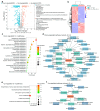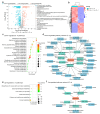Metabolic Influence of S. boulardii and S. cerevisiae in Cross-Kingdom Models of S. mutans and C. albicans
- PMID: 40278145
- PMCID: PMC12028775
- DOI: 10.3390/jof11040325
Metabolic Influence of S. boulardii and S. cerevisiae in Cross-Kingdom Models of S. mutans and C. albicans
Abstract
Recent studies highlight the potential of Saccharomyces species as probiotics due to their ability to modulate microbial interactions and reduce cariogenic activity, yet the underlying metabolic mechanisms remain unclear. This study investigates the cross-kingdom metabolic effects of Saccharomyces boulardii and Saccharomyces cerevisiae on the metabolic processes of Streptococcus mutans and Candida albicans using a metabolomics-based approach. Untargeted LC-MS/MS analysis was conducted to assess metabolites in a planktonic model, followed by metabolomic profiling and pathway analysis to identify key metabolic alterations. The results revealed that S. boulardii and S. cerevisiae demonstrated metabolic regulatory effects on S. mutans and C. albicans. Specifically, S. boulardii down-regulated 262 metabolites and up-regulated 168, while S. cerevisiae down-regulated 265 metabolites and up-regulated 168. Both yeast species down-regulated carbohydrate and amino acid metabolism in S. mutans and C. albicans, resulting in reduced biomolecule synthesis and a less acidic environment. S. boulardii and S. cerevisiae also up-regulated certain metabolic processes, including purine metabolism, suggesting a compensatory mechanism for nucleotide synthesis. Notably, dual regulatory effects were observed, where specific metabolites were simultaneously up-regulated and down-regulated, indicating complex metabolic crosstalk. These findings suggest that both S. boulardii and S. cerevisiae modulate microbial metabolism through a shared mechanism, offering potentials for dental caries prevention.
Keywords: Candida albicans; Saccharomyces boulardii; Saccharomyces cerevisiae; Streptococcus mutans; metabolic influence; microbial interactions.
Conflict of interest statement
The authors declare no conflicts of interest.
Figures






Similar articles
-
Anti-Cariogenic Effects of S. cerevisiae and S. boulardii in S. mutans-C. albicans Cross-Kingdom In Vitro Models.Pharmaceutics. 2024 Feb 1;16(2):215. doi: 10.3390/pharmaceutics16020215. Pharmaceutics. 2024. PMID: 38399269 Free PMC article.
-
Caffeic Acid Phenethyl Ester (CAPE) Inhibits Cross-Kingdom Biofilm Formation of Streptococcus mutans and Candida albicans.Microbiol Spectr. 2022 Oct 26;10(5):e0157822. doi: 10.1128/spectrum.01578-22. Epub 2022 Aug 18. Microbiol Spectr. 2022. PMID: 35980199 Free PMC article.
-
Lactobacillus plantarum Disrupts S. mutans-C. albicans Cross-Kingdom Biofilms.Front Cell Infect Microbiol. 2022 Mar 22;12:872012. doi: 10.3389/fcimb.2022.872012. eCollection 2022. Front Cell Infect Microbiol. 2022. PMID: 35392605 Free PMC article.
-
Current and prospective therapeutic strategies: tackling Candida albicans and Streptococcus mutans cross-kingdom biofilm.Front Cell Infect Microbiol. 2023 May 11;13:1106231. doi: 10.3389/fcimb.2023.1106231. eCollection 2023. Front Cell Infect Microbiol. 2023. PMID: 37249973 Free PMC article. Review.
-
Unveiling the complexity of early childhood caries: Candida albicans and Streptococcus mutans cooperative strategies in carbohydrate metabolism and virulence.J Oral Microbiol. 2024 Apr 10;16(1):2339161. doi: 10.1080/20002297.2024.2339161. eCollection 2024. J Oral Microbiol. 2024. PMID: 38606339 Free PMC article. Review.
References
-
- Astasov-Frauenhoffer M., Kulik E.M. Cariogenic Biofilms and Caries from Birth to Old Age. Monogr. Oral Sci. 2021;29:53–64. - PubMed
LinkOut - more resources
Full Text Sources

